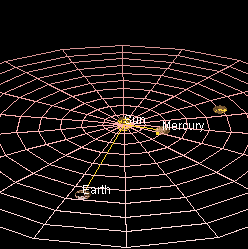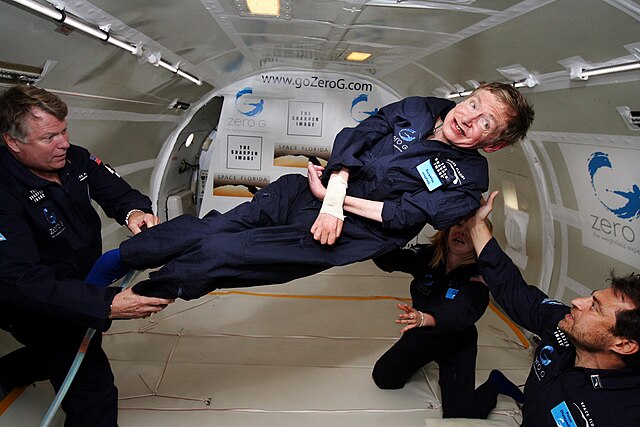Visual physics and mathematics/Gravitation
The force that causes the balls to fall to the ground is the same as the force that keeps the Moon in its orbit. Satellites and projectiles all obey the same law, the law of universal gravitation.
The orbits of the planets
[edit | edit source]Gravitation holds the planets in their orbits around the sun.
The trajectory of a mobile in free fall depends on its initial velocity vector:
But masses subjected to gravitation which have the same velocity vector and which pass through the same point always have the same trajectory:
This is why Saturn has rings:
The law of universal gravitation
[edit | edit source]Two masses exert a gravitational force on each other proportional to the product of their masses divided by the square of their distance. The two forces, that exerted by A on B and that exerted by B on A, are in the direction of the line which connects the centers of the two masses A and B and they are always attractive.
Gravitation between two balls
Two balls attracted to each other by gravity bounce off each other.
The gravitational field
[edit | edit source]A field is a physical quantity that can vary at every point in space at every instant. For example, temperature is a field. The law of universal gravitation says that a mass continuously produces a gravitational force field throughout space:
where is the vector which goes from the mass to the point considered, is its length, is the unit length vector in the direction of and is a constant which depends on the choice of units of measurement.
The force exerted by a gravitational field on a mass is
So the force exerted by a mass on a mass is
On Earth, the weight of a body is the gravitational force that the Earth exerts on it.
The field is like a mathematical intermediary to calculate the force exerted by one mass on another.
The gravitational force exerted by two masses on a third is the sum of the forces exerted separately by each of them.
Two stars revolve around each other.
According to Newton's theory, the force of gravitation is everywhere. It is a force field that fills all space. This field can be derived from a scalar field, the gravitational potential field, here represented by a gradation of colors. The white lines are the lines of force, the lines that always follow the direction of the gravitational force.
The equality of inertial mass and gravitational mass
[edit | edit source]According to the theory of relativity, there is no instantaneous interaction at a distance. One mass cannot therefore instantly exert the force of gravitation on another. The force propagation time must be taken into account. This is why the law of universal gravitation is only a first approximation. To calculate the effects of gravitation more precisely, we need the theory of general relativity.
Einstein's big idea in 1908: if an elevator falls in free fall, its passenger is weightless for the duration of the fall, until the elevator crashes to the ground.
Stephen Hawking in a plane that simulates a free fall
To understand this big idea, one needs to know the following theorem:
If a body is subject only to gravitation, its acceleration does not depend on its mass.
Proof: according to the law of gravitation, the force exerted by a gravitational field on a mass is . According to the fundamental law of dynamics, this force produces an acceleration such that . So , whatever the mass .
In , is the inertial mass, or coefficient of inertia. It is the inverse of the acceleration produced by a unit force. In , is the gravitational mass, or gravitational charge. It is equal to the force exerted by a unit gravitational field.
Newtonian physics does not impose the equality of inertial mass and heavy mass. They could be different. As with the electric field, the gravitational field could cause different accelerations on different bodies at the same point, if the gravitational mass (the gravitational equivalent of the electric charge) was different from the inertial mass.
The equality of inertial mass and gravitational mass means that the acceleration of an elevator in free fall caused by gravitation is always equal to that of its passenger. This is why the passenger cannot observe the effect of gravity in a free-falling elevator. Everything happens as if it were not subject to any force, as if it were weightless.
We feel our own weight, because we feel the force that the ground exerts on our feet. We feel the weight of a body that we carry, because we feel the force it exerts on our hands, or on our back. But these forces of repulsion between the ground and our feet, or between our hands and a heavy body that they carry, are not forces of gravity, but electric forces produced at the contact surface between bodies which repel each other.
According to general relativity, we cannot feel the force of gravity because it is not a force. The force of gravitation does not exist. There is no force, as Newton believed, that pulls us downward. There is only the force of the ground that pushes us upwards.
The floor of a free-falling elevator exerts no force on the passenger's feet, who is therefore not subject to any force, as in weightlessness.
The choice of reference frame
[edit | edit source]According to Newton, the passenger in a free-falling elevator is subject to the force of gravity. According to Einstein, it is not subject to any force. The difference comes from the choice of frame of reference.
A reference frame is a rock, or any solid body, in relation to which we can locate ourselves and make distance measurements. By placing three perpendicular planes on the rock, we can identify all the points in space with the three numbers x, y, z which measure their distances from these three planes. It is assumed that an event occurs once on the rock. This event defines the time t = 0. We can then identify the instants t of all the events with the duration which separates them from the instant t = 0. A frame of reference therefore makes it possible to identify all the events in space-time with four numbers, t, x, y, z.
The measurement of speeds and accelerations depends on the choice of reference frame. If we measure the accelerations on a moving merry-go-round, the result is not the same whether the reference frame is the ground or the merry-go-round.
There are some reference frames better than others. The ground reference frame is better than that of the merry-go-round for studying forces. A rock that does not rotate in relation to the stars is better than a rock that rotates. We can tell the difference between a rock that rotates on itself and another that does not rotate on itself without looking at the stars. All we need to do is place two masses linked by a spring. If the rock rotates on itself and if its axis of rotation is not parallel to the spring, the two masses are separated by the rotation.
Good reference frames for measuring forces are all rocks which do not rotate on themselves and which are not subject to any force. They are called inertial frames.
Moving masses which are not subject to any force:
According to Newtonian physics, inertial frames are all at rest or in uniform rectilinear motion relative to each other, because gravitation is considered a force. A movement is uniform rectilinear if its trajectory is a straight line and its speed is constant.
According to Einstein's theory of general relativity, inertial frames are all rocks that do not rotate on themselves and are in free fall relative to each other, because gravitation is not considered as a force.
The movement of the Moon around the Earth is a free fall. More generally, all bodies that exert no force on each other are in free fall relative to each other, because gravitation is not considered a force. Falls in air are not free falls because of air friction. Falls in the void are free falls.
The difference between Newtonian physics and general relativity comes from the choice of the inertial frames.
According to general relativity the reference frame of the ground is not inertial, because it is not in free fall. It is equivalent to the reference frame of an accelerating rocket:
We feel gravity because we are accelerated relative to a free-falling frame of reference.
A rock that does not rotate on itself, free falling in a tunnel that passes through the center of the Earth, is a good reference frame for measuring the forces inside the Earth.




























